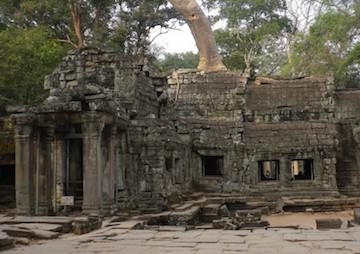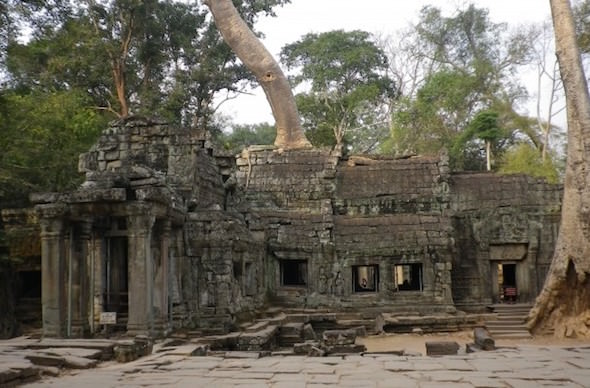Climate Change Helped Trigger Ancient Angkor’s Fall
Scientific evidence is growing that the decline of once-mighty Angkor, the famed temple site in modern Cambodia, was in large part due to abrupt climate change.
By Kieran Cooke / Climate News Network

A temple site at the ancient city of Angkor overrun by jungle. (Kieran Cooke / Climate News Network)
This piece first appeared at Climate News Network.
ANGKOR, Cambodia — At its peak, the ancient city of Angkor — with its innumerable temples and its complex system of canals and fortifications — was the largest pre-industrial city in the world, centre of a vast empire and home to three-quarters of a million people.
Then, over a period of just a few decades in the early 14th century, the site was abandoned, its temples left to be eaten up by the jungle, and its hundreds of kilometres of water channels blocked by tons of sand and earth.
Wars between the Khmer — builders of Angkor between the 9th and 13th centuries — and neighbouring empires in Southeast Asia, plus internal strife and intrigues between rival rulers, are thought to have been among the reasons for the city’s relatively sudden decline.
But a series of studies over recent years suggest that climate change could also have been a decisive factor in the abandonment of the complex, one of the most important archaeological sites in Southeast Asia, and now a huge tourist attraction
Sophisticated system
Rainfall patterns are highly seasonal in Southeast Asia. Angkor’s builders constructed a vast and highly sophisticated system of canals and reservoirs to harness and store the waters brought by the summer monsoon — which generally lasts from May to October and supplies about 90% of the region’s annual rainfall.
The ability to capture and store water — and use it to build up a highly-productive agricultural system — was a key foundation of Khmer power.
Periods of severe drought, sometimes lasting decades, in the 14th and 15th centuries were interspersed with years of intense monsoon rains.
A study of tree rings in the region — based on the rare and threatened cypress species Fokienia hodginsii — shows that periods of severe drought, sometimes lasting decades, in the 14th and 15th centuries were interspersed with years of intense monsoon rains.
This, the researchers conclude, could have wrecked Angkor’s delicate hydrological system and led to the demise of the Khmer empire.
Other studies, based on analysis of sediments around Angkor, also point to drought as a major factor in the downfall of what was, over several centuries, the region’s major power.
Undiscovered areas
A project led by scientists at the University of Sydney, Australia, has used remote sensing techniques to map hitherto undiscovered areas of the Angkor complex. Again, one of the main conclusions of their studies is that unstable weather was a vital contributing factor in Angkor’s decline.
The Khmer rulers were eventually forced to move south to Phnom Penh, the capital of modern-day Cambodia, and take up trading, instead of agricultural production.
Archaeologists say the collapse of other civilisations and ancient centres of power can, in large part, be attributed to changes in climate.
The city of Tikal, in modern Guatemala, central America, was one of the main centres of Mayan civilisation for a number of centuries until it was suddenly abandoned in the mid-9th century.
Studies suggest that a main factor leading to the city’s collapse — and the eventual demise of the Maya — was a severe drought, plus the effects of deforestation in the region.
Kieran Cooke, a founding editor of Climate News Network, is a former foreign correspondent for the BBC and Financial Times. He now focuses on environmental issues.
Your support matters…Independent journalism is under threat and overshadowed by heavily funded mainstream media.
You can help level the playing field. Become a member.
Your tax-deductible contribution keeps us digging beneath the headlines to give you thought-provoking, investigative reporting and analysis that unearths what's really happening- without compromise.
Give today to support our courageous, independent journalists.






You need to be a supporter to comment.
There are currently no responses to this article.
Be the first to respond.